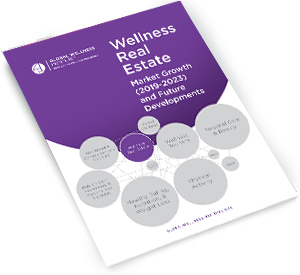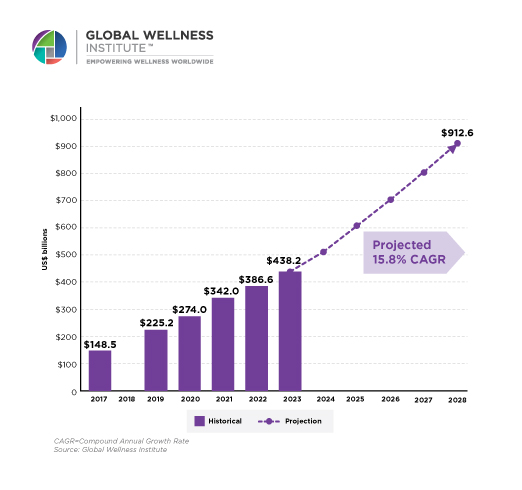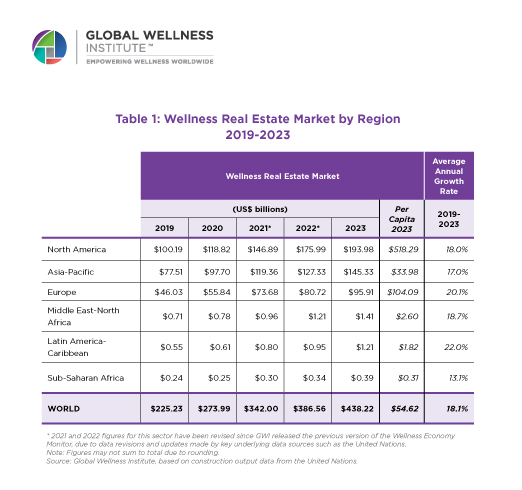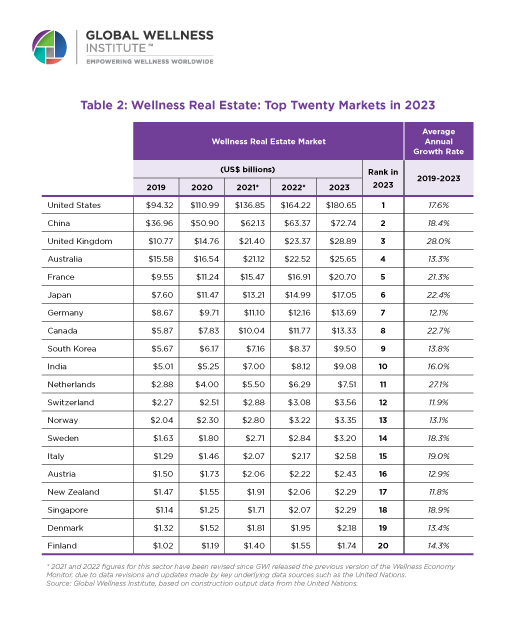Media Contact: Beth McGroarty
[email protected] • +1.213.300.0107
All GWI Press Releases | Press Image Gallery | Global Wellness Institute Press Room | Global Wellness Summit
Wellness Real Estate Market Reached $438 Billion in 2023 and Is Forecast to More Than Double to $913 Billion by 2028
New Global Wellness Institute report reveals a sector that has seen uninterrupted momentum before, during and after the pandemic—with a powerful 18% annual growth rate since 2019

Miami, FL – May 14th, 2024 – The non-profit Global Wellness Institute (GWI), the leading research organization for the global wellness industry, today released a report filled with new data and insights on the global wellness real estate market. GWI defines the sector as homes and buildings that are proactively designed and built to support the holistic health of their residents. The report finds that wellness real estate has been by far the fastest-growing market in the 11-sector wellness economy in recent years, surging from $225 billion in 2019 to $438 billion in 2023. To put that 18.1% recent growth rate in perspective, the annual growth rate for overall global construction was only 5.1%.
With the pandemic dramatically accelerating the understanding among consumers and the building industry about the critical role that external environments play in our physical and mental health, the GWI forecasts that the market will grow 15.8% annually from 2023 to 2028, when it will approach the trillion-dollar mark ($913 billion). The report includes regional and country data, finding that the US ($181 billion), China ($73 billion), and the UK ($29 billion) remain the three biggest national markets. GWI researchers also detail the biggest drivers and opportunities—as well as the biggest challenges—for wellness real estate in the future. The report was released today at the Global Wellness Summit’s third-annual Wellness Real Estate & Communities Symposium in Manhattan.
Download the free report HERE.
“As long-time industry researchers, we’re not at all surprised by this finding,” noted Katherine Johnston and Ophelia Yeung, GWI’s senior research fellows. “More than any other wellness sector, wellness real estate embodies the multidimensionality of wellness. When done right, it has the greatest potential within the wellness economy to improve our holistic wellbeing and that of entire communities. As more people realize that their biggest investment—their home—is the next frontier of health, the demand for wellness real estate will only continue to grow.”
Global Wellness Real Estate Market 2017-2028

Wellness real estate has been the growth leader in the wellness industry since the GWI started measuring it in 2017. During the pandemic year (2019-2020), it was one of the few wellness sectors that continued to grow rapidly (21.6% growth), even as overall construction output and global GDP shrank (-0.8% and -2.6%, respectively). Over the last couple of years, global construction growth has slowed considerably, from 16.7% in 2020-2021 to only 1.9% in 2022-2023. But between 2022 and 2023, wellness real estate grew an impressive 13.4%.

The market is heavily concentrated in North America (44% of total), Asia-Pacific, and Europe, which together account for 99% of the global sector. Latin America-Caribbean and Europe have been the fastest-growing regional markets from 2019 to 2023. Interestingly, Middle East-North Africa remained one of the fastest-expanding markets over the last four years, even with slower construction growth (including a significant construction downturn in 2022-2023). North America has maintained powerful growth since 2017, but it tapered off in 2022-2023 alongside a slowdown in overall construction. Asia-Pacific is home to a number of very large, fast-growing countries for wellness real estate (e.g., Australia, Japan, China, India). At the regional level, wellness real estate growth has outpaced overall construction growth across every single region since 2019, by a factor of 3-4 times or more.

The list illustrates how heavily concentrated the sector is in just a few countries. The US (41% of the market in 2023) and Canada, plus a few countries in Asia (China, Australia, Japan) and Europe (UK, France, Germany), account for 85% of the global market.
Future Opportunities and Challenges: The report identifies 11 key future drivers and opportunities for the market, including how wellness features have become nearly ubiquitous in luxury properties; how healthy buildings will increasingly become key to public health strategy; how both indoor air quality and green/natural assets are becoming essential; and how an interest in planetary health and sustainability is converging with human health and wellness. But the report also outlines six key challenges, including how the rise of extreme weather will drive demand for climate-adaptive features; how the regulatory environment for construction and urban planning frequently stands in the way of wellness real estate; and how the trend of premiumization is widening the gap between the ultra-wellness real estate for the wealthy and the housing built for the average family. It also stresses that the desire for affordable and rental wellness homes represents a major opportunity.
Research sponsors: Fountain Life, which brings together world-renowned medical and health experts to boost longevity and performance, and Arch Amenities Group, the leading provider of amenity management, hospitality consulting and recruiting services for commercial and residential properties, hotels, spas, private clubs, and pools, sponsored the research.
About the Global Wellness Institute:
The Global Wellness Institute (GWI), a nonprofit 501(c)(3), is considered the leading global research and educational resource for the global wellness industry and is known for introducing major industry initiatives and regional events that bring together leaders to chart the future. GWI positively impacts global health and wellness by educating public institutions, businesses and individuals on how they can work to prevent disease, reduce stress and enhance overall quality of life. Its mission is to empower wellness worldwide.























































